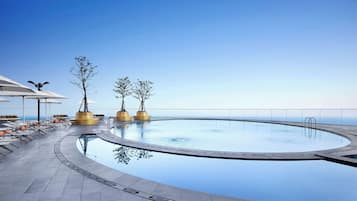There are a variety of unique local dishes you can taste on Jeju Island - Momguk made by boiling pork broth with a type of seaweed called gulfweed; savory, chewy and nutrient-rich broiled black pork; a variety of dishes made with abalone known as the “emperor of the sea;” and seafood ramen featuring fresh seafood that can only be tasted on Jeju Island. There are also the savory and chewy traditional omegi tteok (rice cake coated with red beans), seongge miyeokguk (sea urchin seaweed soup) considered as a dish served to important guests, and kkwong memil kalguksu (pheasant buckwheat noodle soup) with broth stewed from pheasant instead of chicken. As you can see, Jeju offers you diverse selection of dishes that utilize unique and fresh ingredients.
The island has countless things to see and do but, if you decide to only go for delicacies of Jeju Island that cannot be found anywhere else, even a full week may not be enough. In the midst of an incredible, mystical landscape, taste the abundant foods of generous Jeju.
- 1
Galchi jorim
Delicacy from which it is fun to separate its soft, plump fillet

- Couples
- Families
- Food
Galchi jorim (braised cutlassfish) is a sweet and spicy Jeju delicacy cooked by slowly simmering soft-flesh cutlassfish mixed with delicious spices. A bowl of rice disappears quickly if it is accompanied by a plate of braised cutlassfish containing a huge piece of the plump fish body and spicy seasoning. Cutlassfish are rich in minerals and vitamins with a high protein content along with an adequate level of fat, which makes it a good diet food.
There are many different galchi jorim restaurants on Jeju Island with their own unique characteristics, so it is fun to choose where to go for dinner. If you are looking for a place that will wow your mouth and eyes at the same time, we recommend tong galchi jorim (braised whole cutlassfish) restaurants that serve you unchopped cutlassfish that are over 1 meter long. Also, if you don't like the work of separating fish bones, there are also those that serve you boneless braised cutlassfish, so select a restaurant based on what you prefer.
- 2
Momguk
Nutrition-filled soup that will satisfy your stomach

- Couples
- Families
- Food
Momguk is a local Jeju dish that boils the broth made by simmering pork together with gulfweed. It used to be something Jeju haenyeo, who catch seafood underwater for long periods at a time, often ate after they returned to land in order to warm up their cold bodies and supplement calories. The island also has a tradition of cooking pork for every family and village event, so momguk naturally became a banquet dish.
The broth boasts deep flavors by boiling pork, bones and intestines at the same time. A pot-ful of gulfweed added to the broth helps eliminate the greasy flavor of the pork and allows you to enjoy a unique taste. Gulfweed, thinly torn pork and intestines are all chewed softly in the mouth so anyone will be able to enjoy the dish. Once you finish a pot of momguk, you will have a full, satisfied belly.
- 3
Broiled black pork
Delicious broiled pork with savory gravy and abundant nutrition

- Couples
- Families
- Food
Jeju broiled black pork is one of the greatest delicacies. Once you take a bite, savory gravy permeates throughout the inside of your mouth. Black pigs of Jeju tend to adapt well to Jeju's unique climate and natural characteristics, which allow them to have robust physical constitutions and to be highly resistant to diseases. The pork is rich in unsaturated fatty acids that help prevent the accumulation of cholesterol, promote circulation of blood and, also, discharge heavy metal out of the body. Jeju black pork can be said to be a premium pork with better taste along with a higher nutritional value than regular pork.
The taste of thickly cut pork, roasted over a hot broil, after a slight dip into salted anchovy sauce or salted chromis sauce is excellent. Every time you chew the meat, delicious and savory gravy explodes and, also, the texture is incredibly chewy. There are many famous black pork restaurants on Jeju Island allowing you to enjoy black pork to the fullest wherever you visit.
- 4
Abalone
High-class seafood also known as the emperor of the sea

- Couples
- Families
- Food
Since the old days, abalone has been a valuable marine product insomuch that it is known as the emperor of the sea. Its excellent flavors and mouthfeel make it extremely popular among many people. Among countless fresh seafood that one can enjoy on Jeju Island, abalone, in particular, are served in a wide variety of dishes.
People on the mainland typically eat abalone in a oatmeal or on a broil but, on Jeju Island, you can taste abalone steamed or broiled as well as in a cold raw abalone soup, shabu shabu, earthen pot or hot pot, oatmeal, or gimbap. Such a wide selection is awesome. We especially recommend abalone hot pot rice, which contains abalone intestines inside the rice. You can taste the original flavors of abalone and also have the pleasure of eating nurungji, or rice crusts, at the end so, once you finish the meal, you will have an extremely satisfied stomach.
- 5
Broiled mackerel
Delicacy with harmony between crispy skin and moist fillet

- Couples
- Families
- Food
One of Jeju's famous delicacies, broiled mackerel, is a simple and clean dish from which you can taste the original flavors of the fish. While typical mackerel consumes shrimp and anchovy, mackerel in the coastal waters of Jeju feed on seaweed, which is why it boasts the greatest quality. Although it is not difficult to eat broiled mackerel on the mainland, large Jeju mackerel with a fresh and plump fillet, present a taste on another level.
A well-grilled, golden-coloured mackerel and its moist fillet found underneath the crispy skin are a perfect sidekick to white rice. Mackerel have a rich content of various nutrients such as protein and Omega-3, which help improve brain health and prevent vessel diseases and aging, so make sure to try it when you visit Jeju.
- 6
Seafood ramyeon
Ramyeon filled with fresh seafood

- Couples
- Families
- Food
Jeju's seafood ramyeon is filled with fresh seafood and, resultantly, presents a whole new taste compared to those available on the mainland. On Jeju Island, there is no seafood ramyeon franchise; instead, each seafood ramyeon restaurant sells its own unique ramyeon. From ramyeon with whole mussels, crab and shrimp and ramyeon made by seafood freshly caught by haenyeo to octopus ramyeon featuring live octopus and those with one of Jeju's specialties, crayfish, you have a wide range of different ramyeon you can taste.
It would also be really fun to tour only the delicious ramyeon restaurants during your trip to Jeju. When you get hungry after hours of enjoying the beautiful landscape of the island, satiate your hunger with seafood ramyeon. Beverage a sip of the spicy ramyeon soup while looking out onto the blue sea of Jeju Island. You will be so satisfied that you will feel as if there's nothing to envy in this world.
- 7
Omegi tteok
Traditional rice cake that is sweet, savory and chewy

- Couples
- Families
- Food
Omegi tteok is a specialty product of Jeju that is also popular on the mainland. It is made of made-on-Jeju glutinous millet as the main ingredient and boasts a sweet, savory taste. There are no types of grains that grow well on the barren land of Jeju but millet is actually one of the kinds that can be cultivated easily. Omegi tteok is made by kneading millet and flour and boiling them in hot water. The inside is filled with red bean paste, which makes it sweet enough while allowing you to enjoy the original taste of the rice cake covering, and this is the reason why it is widely loved by tourists from other regions.
There are rice cake shops with over 30 years of history still remaining so you can taste chewy Omegi tteok made in the traditional method. Various attempts with a modern touch are carried out these days such as adding Hallabong instead of mugwort or mixing nuts with red bean paste, which offer you a wider range of fun choices. We also recommend picking some up as a travel souvenir to share with your family and friends!
- 8
Samgyetang
Healthy, nutrient-rich dish

- Families
- Food
Samgyetang (ginseng chicken soup) is a delicacy of Jeju known for its body-nourishing effect thanks to a variety of special ingredients such as abalone. Samgyetang is a popular food to eat on Bongnal (Three Hottest Days) under the serious summer heat but, on Jeju, there is a day of eating chicken instead of the Bongnal. A myth has it that, if one catches and eats chicken on June 20 on the lunar calendar, it would nourish his/her body and help cure all kinds of diseases. This is why Jeju Island has many restaurants that serve delicious samgyetang.
As Jeju is an island surrounded by the sea on all sides, you can taste samgyetang with abalone added, which makes the dish even healthier. Samgyetang is known to warm your body and protect your stomach. By finishing a bowl of abalone samgyetang filled with flavors and nutrition, you will be able to recharge your body and soul that have become weakened by the summer heat. Take care of your body with samgyetang and enjoy an even more delightful trip.
- 9
Seongge miyeokguk
Delicacy of nature that holds the sea

- Couples
- Families
- Food
Seongge miyeokguk (sea urchin seaweed soup) is a symbolic local dish of Jeju Island that used to be served to important guests. On Jeju Island, sea urchins are called “gusal,” so the soup is also known as “gusalguk.” Seongge miyeokguk on Jeju-do is a must-serve dish at a banquet, funeral or any other family event. There is even a saying that “Jeju's generosity comes from sea urchin soup.” As you can tell, people of the island regarded it as a delicacy and served it to important guests. In particular, the amount of sea urchin roe included in the soup even became a barometer on the level of sincerity expressed.
In seongge miyeokguk, the soft mouthfeel of sea urchins and the chewy texture of seaweed form great harmony inside warm soup. Moreover, sea urchins are full of vitamins, iron and calcium while seaweed contains a rich content of calcium as well, so the soup is excellent in terms of nutrition. Pour a bowl of hot rice into the sea-scented sea urchin seaweed soup and enjoy it with crispy kimchi.
- 10
Kkwong memil kalguksu
Local kalguksu with simple tastes and balanced nutrition

- Couples
- Families
- Food
Kkwong memil kalguksu (buckwheat noodle soup with pheasant) is a local dish of Jeju that adds thinly and broadly sliced buckwheat dough to pheasant broth. Jeju Island does not have a suitable climate and natural conditions for rice farming, so farmers on the island have engaged in dry-field farming of mixed grains, which has led to the development of sujebi (hand-pulled dough) food culture. Because chicken is deemed too precious, islanders hunted pheasants to make the broth. This is how kkwong memil kalguksu was born.
Kkwong memil kalguksu consists of pheasant meat, which is a low-fat and high-protein food; broth stewed from calcium-rich pheasant bones; buckwheat starch with an abundance of rutin; and vitamin-rich white radish. The pheasant broth has a mild scent with a simple but savory taste. The pheasant meat found in between the noodles is so chewy that it makes it a fun eating experience. The dish has well-balanced nutrition and is especially good for growing children and the elderly, so enjoy it with family.


















